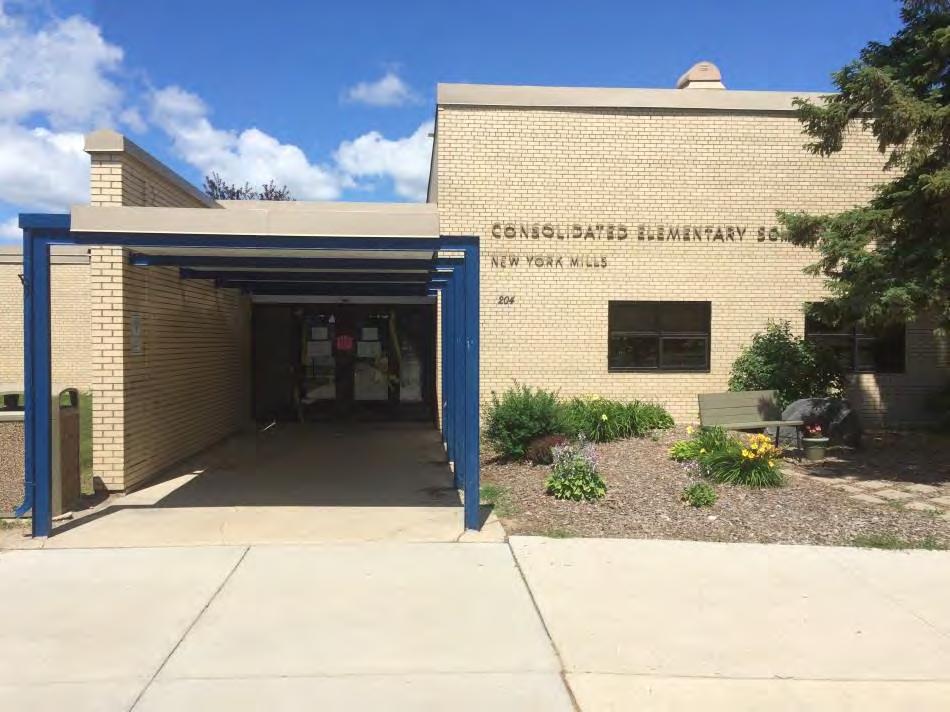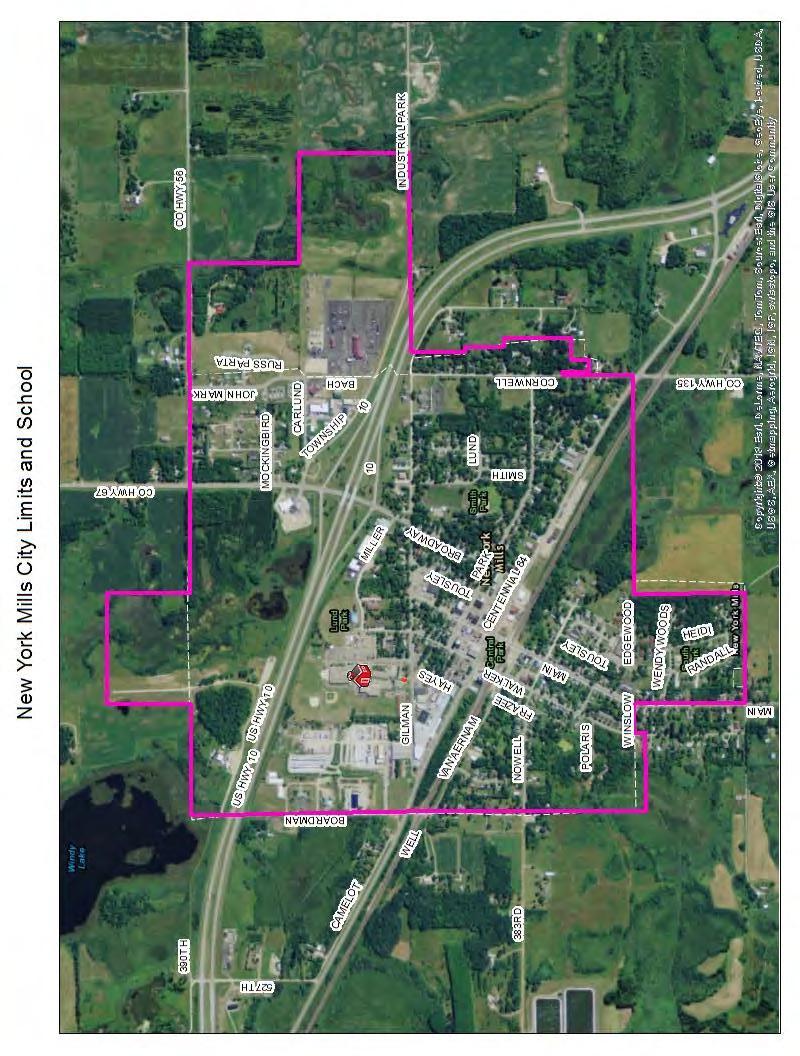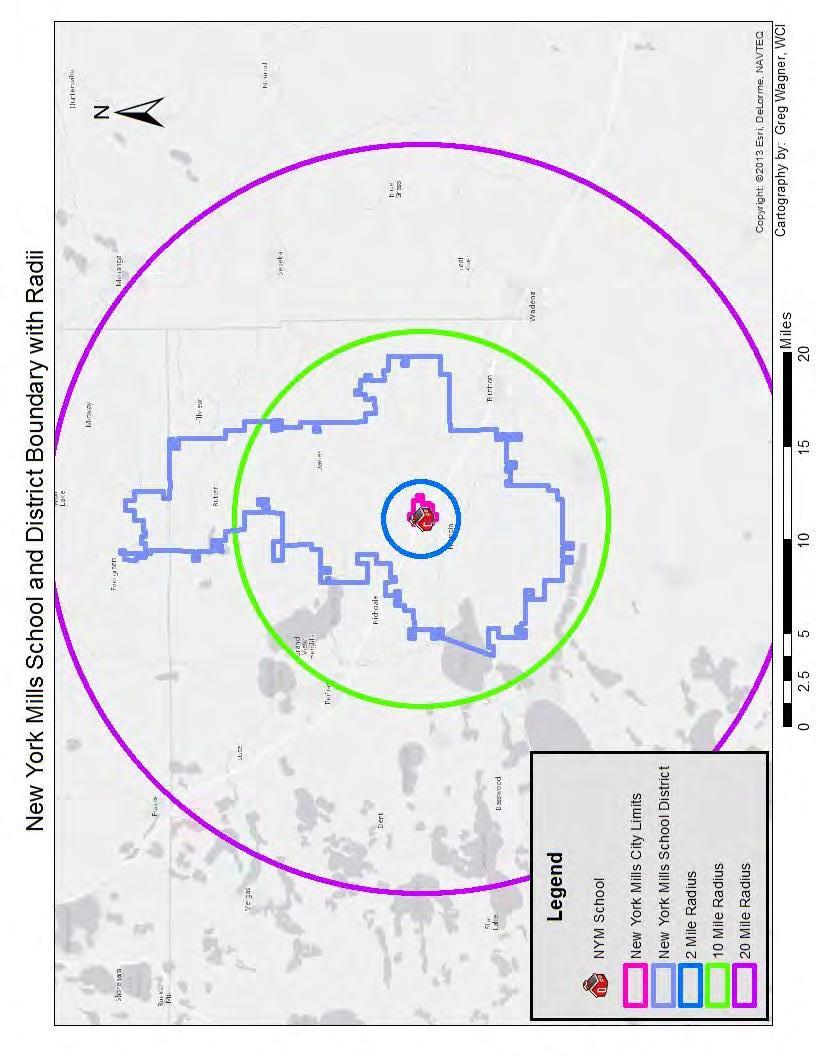
7 minute read
School and District Profile
According to the 2010 U.S. Census, the City of New York Mills has a population of 1,199 people, 533 households, and 287 families, all living within the 1.30 square miles. This gives the City a population density of 922 residents per square mile. The median age in the city was 38.9 years. 23.9 percent of residents were under the age of 18. The racial makeup of the city was 94.8 percent White, 0.3 percent African American, 1.8 percent Native American, zero percent Asian and 2.8 percent from two or more races. Hispanic or Latino of any race was 1.8 percent of the population.16 As of 2014, the top five industries in Otter Tail County by the number of persons employed in order are “Education and Health Services”, “Trade, Transportation and Utilities”, “Manufacturing” , “Leisure and Hospitality”, “Professional and Business Services.”17
S C HOOL AN D DI S TRI C T P ROF IL E
The New York Mills Elementary School is located at 209 Hayes Avenue, in New York Mills, MN. It is located on the northwest
edge of New York Mills, contiguous with the old city core and the surrounding residential development in the city (Figure 20). The elementary school shares the same building as the New York Mills High School and serves students grades PreKindergarten through 6th. On the first day of school in September 2015, the school had an enrollment of 184 students. The breakdown of students per grade is shown in Table 1. 44.3 percent of students are eligible for free and reduced cost meals.
Figure 19: Entrance to the New York Mills Elementary School section of the school building.
16 US Census Bureau. American Fact Finder. 2010. Accessed June 16, 2016.
17
Minnesota Department of Employment and Economic Development. Quarterly Census of Employment and Wages Accessed June 16, 2016
P a g e 52 | Chapter 4: Community and School Profiles
Table 1: Number of Students per Grade (First day - School Year 2015-2016)
Grade Size PreK 32 K 68 1st 58 2nd 60 3rd 66 4th 49 5th 62 6th 56
The New York Mills School District itself is large: encompassing approximately 183 square miles. It is located mostly in northwestern Otter Tail County but extends into a portion of southeast Becker County. The district extends approximately 16 miles north, 8 miles south, 9 miles east and 7 miles west from the school. Roughly three-fifths of the district is north and east of New York Mills and the U.S. Highway 10 corridor that traverses the district. The furthest corner of the district is roughly 17 bee-line miles north of the school in Evergreen Township in neighboring Becker County (Figure 21).
NEW YORK MILLS INDEPENDENT PUBLIC SCHOOL DISTRICT MISSION STA TEMENT
Motto
Preparing Students for Life
Mission Statement
It is our mission to provide opportunities for students to achieve their personal best, become responsible and productive citizens, and embrace lifelong learning in a safe and positive environment. We believe all children can learn and excel with developmentally appropriate materials, practices, and strategies. School is not just about children: it encompasses families, parents, community, stakeholders, society, the environment and beyond.
Source – New York Mills Independent School District website
Chapter 4: Community and School Profiles | P a g e 53

Figure 20: The New York Mills city limits and school location.
P a g e 54 | Chapter 4: Community and School Profiles

Figure 21: The New York Mills School District, New York Mills City Limits, New York Mills Elementary School location and concentric radii from the school location.
Chapter 4: Community and School Profiles | P a g e 55
The New York Mills School District has two transportation policies deemed directly relevant to SRTS. Reviewed for this plan were policy “707L Transportation of Public School Students” and policy “709L Student Transportation Safety Policy” both originally adopted in 1996 and last revised in 2012.
Policy 707L Transportation of Public School Students is a general policy stating the ground rules governing which students are eligible for school district funded motorized transportation to and from school and other school functions and services consistent with the requirements of the law. It “recognizes that transportation by school bus is a privilege and not a right for an eligible student.” Of note in this policy is that the school district will provide transportation “for all resident students who reside two miles or more from the school” as per state statute Minn. Stat. § 123B.88, Subd. 1. However, the policy does provide exceptions to transport students due to “various hazard situations, i.e. railroads, highways, etc.” Also, “School buses will pick up and deliver country students to their residence if the lane is one-half mile or more in length” with the possibility of reasonable exceptions due to health concerns. If these policy guidelines are followed (the policy does grant the school district the discretion to bus any and all students), then the policy is consistent with the goals of SRTS planning and the MnDOT Walk / Bike Zone concept.
The “709L Student Transportation Safety Policy,” like most other 709L policies in the State of Minnesota, is primarily focused on transporting students to school via school buses. The policy states, “The purpose of this policy is to provide safe transportation for students and to educate students on safety issues and the responsibilities of school bus ridership.” However, it does include several lines regarding and even promoting walking and biking. The policy states that, “The school district may provide student safety education for bicycling and pedestrian safety for students in grades K through 5” (note the word “may”). And that “Parents/Guardians are responsible to … support safe riding and walking practices, and recognize that students are responsible for their actions.” While again the policy states that “riding the school bus is a privilege, not a right,” it does not offer specific guidelines for students living within safe walking and biking distance to school as defined by MnDOT’s Walk / Bike Zone concept (See Chapter 2). Beside these brief mentions, there are no specific guidelines for students, parents, teachers and administrators for those students who choose to walk and/or bike to and from school. For example, there are no guidelines for when and where crossing guards are warranted, nor are there guidelines for crossing guard qualifications and training. By comparison, there are multiple pages detailing the qualifications and training of school bus drivers, their duties and responsibilities, operating rules, as well as school vehicle maintenance standards amongst many other details regarding school bus operations.
The complete New York Mills 707L Transportation of Public School Students policy can be found in Appendix F and the 709L Student Transportation Safety Policy in Appendix G.
P a g e 56 | Chapter 4: Community and School Profiles
NEW YORK MILLS SCHOOL DISTRICT WELLNESS POLICY
The New York Mills School District “533L Wellness” policy was originally adopted in 2006 and then last revised in 2010. “The purpose of this policy is to assure a school environment that promotes and protects students’ health, well-being, and ability to learn by supporting healthy eating and physical activity.”
The wellness policy specifically acknowledges that, “students need opportunities for physical activity and to fully embrace regular physical activity as a personal behavior, ” and that “Students will be given ageappropriate opportunities for physical activity before and after school.” However, there are no specific mentions of promoting or encouraging walking and/or biking to and from school as part of a comprehensive strategy to promote student wellness and/or encourage and promote lifelong healthy behaviors and lifestyles in students.
The complete New York Mills School District “533L Wellness” policy can be found in Appendix H.
NEW YORK MILLS CITY SIDEWALK ORDINANCE / REGULATIONS
The City of New York Mills’ website only hosts a handful of the city’s ordinances with only those thought to be of likely use to city residents found online. Of those hosted on the website, Ordinance 47 requires the clearance of snow and ice on the public sidewalk by the adjacent property owners with 24 hours. No specific ordinances requiring the maintenance, repair or replacement of sidewalks within the city right-ofway were found on the city website but may be in the city archives.
RECOMMENDATIONS
Policy recommendations to improve SRTS can be found in the beginning of this document in the subchapter titled “Action Plan Recommendations” in the “Encouragement” and “Other” sections, with further policy recommendations found in Appendices D and E.
Chapter 4: Community and School Profiles | P a g e 57





